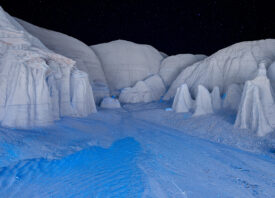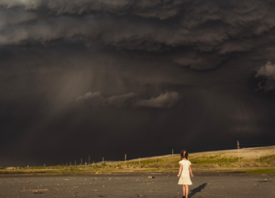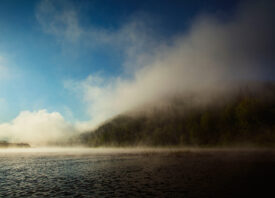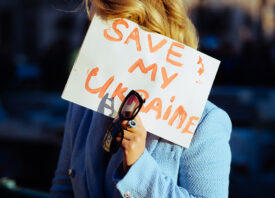Search this site
Inside An NFT Collector’s Eclectic Photo Gallery

Peter Molick’s photography collection brings us around the world, from the unforgiving polar nights of Russia’s Kola Peninsula, captured by Simon Roberts, to the sun-baked landscapes of the American West, photographed by Cody Cobb. Craig Whitehead hits the streets of Cambridge, while Dino Kuznik takes in the view at Monument Valley.
The collection spans genres and media, ranging from cyanotypes, an alternative process dating back to the 19th century, to experimental digital techniques. Yael Malka uses cutouts to record several views onto a single piece of film, and elsewhere, Diane Meyer mixes embroidery and photography.
A photographer himself, Molick seems drawn to work that defies the odds, breaks the rules, or imagines the impossible. In a relatively short time, the artist, who goes by the moniker PixelPete, has built a collection that speaks to the past, present, and future of photography. But this collection isn’t housed in a museum or estate; it lives on the blockchain, in the form of NFTs. We asked him to tell us more about his entrée into crypto art, the market for photography NFTs, and the work that inspires him.

When did your interest in NFTs begin?
“I have been involved with NFTs on and off since 2017. In late 2020, a close friend, Erick Calderon, created Art Blocks, which is a platform for generative art. He brought me on as a curatorial board member and later an advisor. This ramped up my involvement with NFTs substantially during their run-up last year.
“I had long thought about where photography might fit positionally within the space and had some hesitations along those lines, and it wasn’t until much later during some early conversations in the Obscura Discord that it began to really click for me how good of a fit it is.
“Despite having sold out a collection of my own, Crossings (Houston), I hadn’t fully bought into the idea of photographs sold as NFTs. But during this conversation, it really became clear to me that an NFT of a photograph is essentially the digital edition offered of that work by an artist, and it can be as simple as that.
“It was also during this conversation that someone used the analogy of film-to-prints versus digital files-to-digital editions where I began to think a little outside of my normal framework and came to the realization that even in traditional photography sales in the art market, the print is already the non-native format being created as something we collect, and that this digital edition can be thought of similarly.”


What was your first purchase?
“The first real photographic work I collected was actually a mixed media work by Reuben Wu titled Theory of Forms. I have long been a fan of Reuben’s use of technology, unique landscapes, and his musicianship and had thought that his work was always a good fit as a digital offering. So after having some major success with collecting and selling work in the generative art space, I purchased this work. Shortly after that, I purchased a work from Alejandro Cartegena’s collection Suburbia Mexicana and it grew from there.”
Do your purchases have anything in common, even amid the diversity of your collection? Is there a common thread?
“I try to collect work that resonates with my sensibilities more than anything. As my collection and knowledge have evolved, I have opened up to new types of work and developed more of an appreciation for work with a strong narrative voice and those with strong socio-political underpinnings. That said, as someone with a background in design and with a long involvement in the arts, I always lean on strong aesthetics and creative use of the medium.”

Why do so many collectors remain anonymous? And what made you decide to reveal your identity?
“This is an inherent part of cryptocurrency, which ironically stems from its roots in transparency. Because transactions, account balances, and information are readable on the public ledger that the blockchain provides, many opt for anonymity as a form of personal protection. For example, with a little understanding of the Ethereum blockchain, one can discover that I made a sale of a single NFT for a substantial amount. This is very uncomfortable to have out there so publicly.
“I opted to be transparent about my identity early on when the stakes weren’t very high because I wanted to make work available as an artist and didn’t see an advantage to trying to conceal that, especially when my name is the same as my business. I also think it’s important to have some of us willing to be transparent about who we are in order to provide some credibility to the overall ecosystem.”

It seems that NFTs level the playing field in photography. You don’t necessarily have to have a successful career in a gallery to sell work at high prices. Why do you think this is?
“NFTs level the playing field in a number of ways. We now have this worldwide market with instant connectivity that allows artists to share work across the globe and for collectors to obtain it immediately. This level of access and ease of sharing allows for opportunities and, of course, also should signal to collectors to do their own due diligence when considering purchasing work to know who they are purchasing from and the impact that may have on its long-term value.
“One thing I think about is that these people experiencing early success may learn hard lessons down the line if that success was fleeting and they aren’t able to sustain the momentum long term. I’ve also observed many inexperienced artists expecting to find immediate success, which I think is due to the flatness of Twitter and these platforms.”

Do you research the photographer before you buy an NFT from them? If so, what are you looking for?
“Yes, I tend to always dive down a bit of a rabbit hole to learn more about who the artist is that I’m considering buying the work of. This includes looking at their websites for examples of past work, personal and professional; learning a bit about them from their social media; and if they are established, learning more about what and where they have exhibited work. That said, I also find value in helping emerging photographers and, if I find something in the work, won’t hesitate to buy.”

How do you find most of the work in your collection?
“I try to cast as wide a net as possible. Much of what I find is via Twitter now that I have a fairly broad network, but I also search platforms like Foundation, SuperRare, and OpenSea fairly often (well, maybe not so much OpenSea; it’s a mess) for new projects. As people follow me both on social media and Foundation or SuperRare, I will quickly click through to those to see if anyone is a photographer, and if so, if they are creating anything that appeals to me, whether it’s available as NFTs or not. I also lean on curatorial platforms such as Assembly, NFTphotography, and Fellowship for discovery.
“Another thing I’ve been thinking a lot about is onboarding photographers who I know from outside of the space who might be NFT curious but intimidated by it. I’ve been an architectural photographer for seven years now and have developed a pretty large network of peers across the globe whose work I really admire, so have been working on a small side project where I would collaborate with them as a way of making the onboarding simpler. So occasionally I find people through those efforts as well.”

Do you ever find work in the sea of shill threads on Twitter?
“I will look at them from time to time if they seem to be yielding interesting results. For example, Justin Aversano recently acquired some work of mine along with a few others, and in doing so, created a thread for people to share work, and much of what was shared was quite interesting. I followed several people from that but don’t remember specifically if it led to any collecting.”

How do you see the role of curators in the NFT space evolving in the future?
“This is something I consider to be critical to the longevity and success of the space. Many people are collecting artwork for the first time in their lives and have little knowledge of its history. This can be both good and bad, as the traditional art world has its own problems and barriers of entry.
“Long term, I think it’s really important that people rise up to help educate others on how to think critically about work being created and the meaning of artists who can create consistent, impactful projects. I believe this will come from individuals, organizations that develop out of the space such as Assembly, Fellowship, Obscura, UntitledDAO, and arts institutions.
“More and more, as the number of photographers involved with NFTs grows, I think it will be necessary to have agencies and others with curatorial voices who can help in the effort to educate and share work as a trusted resource.”

As a collector, how do you feel about photographers selling multiple copies of their NFTs? Have you ever bought an NFT that was part of a set of, say, an edition of ten?
“Generally, I am not a fan of this but think there could be room for it in some cases. One example is that if an artist’s work is generally unattainable to most, making a larger edition available could be a good way to allow the collecting of their work from others. Reuben Wu did this once and it was well-received.
“My personal feelings, though, are that I prefer there be one digital token of the artwork, which helps it feel special and preserve scarcity. Photography is already viewed differently in art markets due to our ability to create multiples, so having some limiting factor in this new space is helpful, I think.”

Do you see many photographers thinking out of the box when it comes to releasing their NFTs? If so, what’s been memorable to you?
“I would say that I think there are a lot of people thinking about it but only a few really pushing boundaries so far. I’m excited to see this evolve. Misha de Ridder has a real grasp on some of the possibilities of release mechanics and has done some interesting things, most recently with his project Generative by Nature. Reuben Wu created an interesting interpretation of his work for his project Aeroglyph Variations with Obscura.
“Others have done interesting things with how to share their work, such as Danielle Ezzo’s work If Not Here Then Where, where she created a dedicated website and virtual gallery to explore the work. Mia Forrest’s Bloom is another that seems uniquely positioned for NFTs. And Stephanie Lenee Vance’s work Echotombs was made in a way that specifically utilizes the blockchain as part of its core.
“That said, I also have learned a lot from and really appreciate the quality of documentary and story-driven work that has been collected and recognized. Sometimes simplicity is the best approach.”

Are there any photography collections do you wish you had in your collection that you don’t?
“The number of quality projects that are shared on a weekly basis can often leave me wanting. But to be honest, there aren’t a lot that currently exist in the photography NFT space that I’m aware of that leave me really wishing I had.
“I have a loose rule that I try to limit myself to one work per artist and limit my spending generally under 1 ETH per image and occasionally a bit more (Reuben’s work being the major discrepancy here). I do that to spread my spending around as much as possible to help artists find some recognition.
“This occasionally leaves me wanting additional pieces from certain artists who I really admire–Thomas Jackson, Gijs van den Berg, Mia Forrest, for example–and some of the more narrative work where having multiples would help to tell the story better, such as Cristina de Middel’s and Poulomi Basu’s projects.
“However, with the latter, I think this is also something that makes the space so special; we can immediately link back to the larger collection to give a sense of the greater narrative behind the work, whereas with print sales, there is often a disconnect once a print has been collected.”

Do you think a secondary market for photography NFTs exists? If so, what drives this market?
“This is something I consider a lot and certainly don’t have the answer to. I am in a position to collect without expectations of a return but of course think if a secondary market can develop and sustain itself, it will play a big part in the longevity of photography in this space.
“Currently, it’s hard to tell because the pool of collectors actively seeking out and buying photography NFTs is small, and more education of photography in the space is needed to expand that. I do think that with time, we will see more collectors take up an interest in photography and as that base grows, it’s possible that so too will the secondary market. Photography is inherently more human and personal than most of what we see in the NFT world, which I think will help it sustain long term.
“One thing that I think will help drive that market is preserving some layer of scarcity in the work, which as things currently stand, is largely up to the photographers to decide how much work they will put out and at what level of curation. Many people are putting out large bodies of work consecutively, which I think ultimately could reduce the value of their ‘brand’ if they don’t approach things strategically.
“The other question related to this is that if we see a large dip in the NFT/crypto markets, what the impacts will be in the short term for people who hadn’t quite gotten their footing yet or decide not to stick around. Lots of unknowns, but also lots of opportunities!”

I’d love to return to your own work as a photographer for a bit. Why do you think Crossings, Houston and Venice, are particularly well-suited to the NFT space?
“I do think Crossings is an interesting example that straddles the territory of a collectible series and more typical photographic work, which is an interesting position in the NFT space. Many collectors are coming into the appreciation and collecting of photography for the first time, often from other sorts of NFT projects, so think there is an aspect to my project that scratches that itch and makes it easier to grasp in that way.
“In 2016, I participated in the portfolio reviews at the FotoFest Biennial and was sharing the Crossings project at the same time it was showing in Venice. I remember being so energized by the idea of creating many more Crossings, featuring a diverse selection of cities across the globe and how well received the idea was.
“Shortly after, the laws around flying drones began to tighten and my professional work really picked up, so that got put on the back burner. But I have recently rehashed that concept in a way that will also appease my desire to help onboard new photographers to this space, so I look forward to sharing more soon as that develops.”

How has your eye as a collector influenced your journey as a photographer? And vice versa?
“This is something I’ve found myself thinking about a lot lately. Through collecting, I think I’ve learned a lot in a short time about the importance of capturing human moments–or even those moments that might feel more mundane but are enhanced by the artistry behind one’s ability to identify and capture them well.
“With my professional practice, I have perfected the ability to create very high-quality images of spaces and people’s embodiment of them for commercial purposes. This new understanding has me looking at the world in an entirely new way, which I think I have yet to really translate through the lens just yet. But I find myself thinking a lot about creating more observational work as a personal endeavor and have the photographers whose work I’ve collected as well as this community, on the whole, to thank for that.
“I’ve also always had an interest in the back of my mind in creating work that involves self-made installations or compositions that are then photographed, so think that has been sort of reinvigorated by the work of photographers I’ve collected like Thomas Jackson, Yael Malka, Danielle Ezzo, David Brandon Geeting, Diane Meyers, Cameron Getty, Kevin Cooley, Brett Cody Rogers, and Thomas Albdorf in addition to others who I’ve long admired, such as Laura Plageman and Alma Haser.”

What are your plans for your collection as it continues to evolve?
“I’m not sure! Lately, my focus has been on thinking of ways to better share what I’ve collected as an example of what is being recognized and being made available in this world that is so intimidating to those on the outside. This is what led me to make the first draft of my website pixelpete.gallery, where I can really shape the viewing experience how I want to while also providing the artists’ descriptions as well as some commentary of what I see in them.
“This will evolve, but I have wanted to create a resource that I can share with people outside of the NFT space for a long time. I want to shares this type of work and also have a resource for teaching them about the technical side of things and helps to onboard collectors and artists. This last part is a work in progress.”



